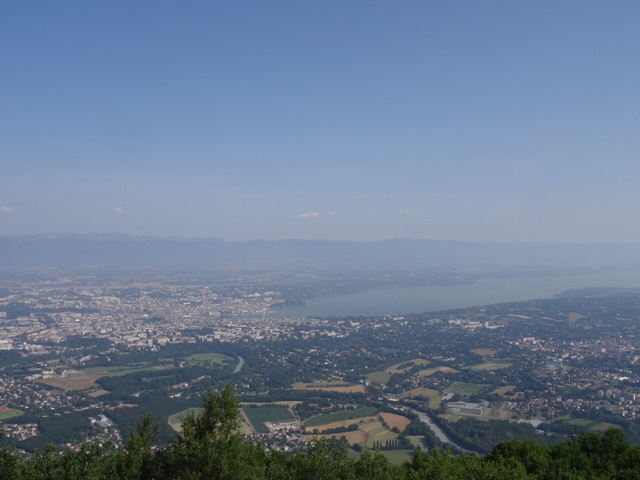Overlooking Geneva is the majestic Mont Salève. It’s not actually in Switzerland at all; it’s firmly in France, just across the Franco-Swiss border. Its limestone cliffs are the backdrop to an already picture-perfect Swiss city, and the views from the top are breath-taking. I’d seen them before, but was only too happy to see them again.
An early start was in order, as we were aiming to catch the first cable car of the day up Mont Salève. We caught the number 8 bus from Gare Cornavin all the way to Veyrier-Douane; this was included in our free travel pass, and the journey took about thirty minutes. From here, it’s a hop, skip and a jump across the border and into France. There’s a small cabin for border control, though there was no one about when we passed through; that said, it’s worth having your passport on you, as you never know when someone will be around and want to check. A short walk later, we found ourselves at the ticket office for the Téléphérique du Salève, along with what looked like about a hundred schoolchildren. (Luckily they all dispersed at the top, so it didn’t feel crowded.) Mont Salève is in France, but its proximity to the Swiss border means that you can pay in either euros or Swiss francs; there’s a fair exchange rate in place, so it doesn’t really matter which currency you use.
Despite the hordes of schoolchildren, we didn’t have to wait long to board a cable car to the summit. It’s a speedy ascent: 1,100m in less than five minutes. There’s no real need to snap away in the cable car, as there’s a viewing platform by the cable car station at the top, and plenty of photo opportunities for those who decide to take a little walk at the top.

As we were fairly short on time, we just did a short circuit round the top, as far as the Buddhist monastery. Lots of brightly coloured prayer flags fluttered in the wind; not far away, paragliders launched themselves off the mountain, riding the gusts of wind down to the foot of the mountain.
By late morning, we felt we ought to head back down to Geneva, as we hoped to go on a tour of the Palais des Nations (UN) that afternoon. We arrived back in Geneva around 12:30, which left us with plenty of time to pick up a bite to eat and head over to the UN. We checked out the sculpture Broken Chair, which represents opposition to landmines, and stands in Place des Nations opposite the Flags of Nations.
We enjoyed a picnic lunch in Parc de l’Ariana, before heading over to the UN in time for the 14:00 tour. Guided tours last one hour and most are conducted in either French or English; other languages are available, but you should check the timings of these beforehand. All of us studied French, so we could have taken a French tour had there been one running at the time we visited; as it was, we settled for English.
On our tour, we were able to (briefly) listen to the interpreters in action during a meeting in the Human Rights and Alliance of Civilisations Room; the ceiling of this room is pretty wacky, though we weren’t allowed to take photos due to the meeting that was in progress. The Emirates Room – recently renovated and funded by the UAE government – was particularly interesting, as each feature evoked desert life: from the dune-coloured carpet to the LED lights that twinkled like stars in the desert sky. Our guide gave us a comprehensive overview of the history of the Palais des Nations and its predecessor, the League of Nations, and we left with a clearer idea of what the UN actually do on a day-to-day basis.
Afterwards, we spent a little more time in Parc de l’Ariana, before returning to the hostel to retrieve our belongings. Sally was heading to the airport for a late afternoon flight, while Olivia and I still had a few hours before we needed to part ways. With the sun still shining, we wandered back down to the lake for one last ride on the mouettes followed by a picnic tea in the gardens just off Quai du Mont Blanc.
Tips:
If you’ve taken the bus to Mont Salève, you’ll have to cross a single line of train tracks to get to the cable car station (or start of the trail, if you’re hiking). Don’t linger on the tracks, and if the alarm sounds move off them as quickly as possible. As we were scurrying across the tracks the alarm sounded, the barriers came down promptly and barely thirty seconds later a train whizzed by at breakneck speed. Here, it is most definitely not a case of ‘slow and steady wins the race’.
Cable cars run regularly up Mont Salève, but do keep an eye on the weather forecast as they can be cancelled if the weather is particularly bad. If you’re under 26, you’ll qualify for the ‘Tarif Éco’ – a reduced-price ticket, at €8.60 return or €5.60 one way. Check the official website for more information.
From September to March, the UN only offers tours on weekdays; between April and August, tours are available on weekdays and Saturdays. Security is in place, and you will need a valid form of ID to visit. Find out more on their website.